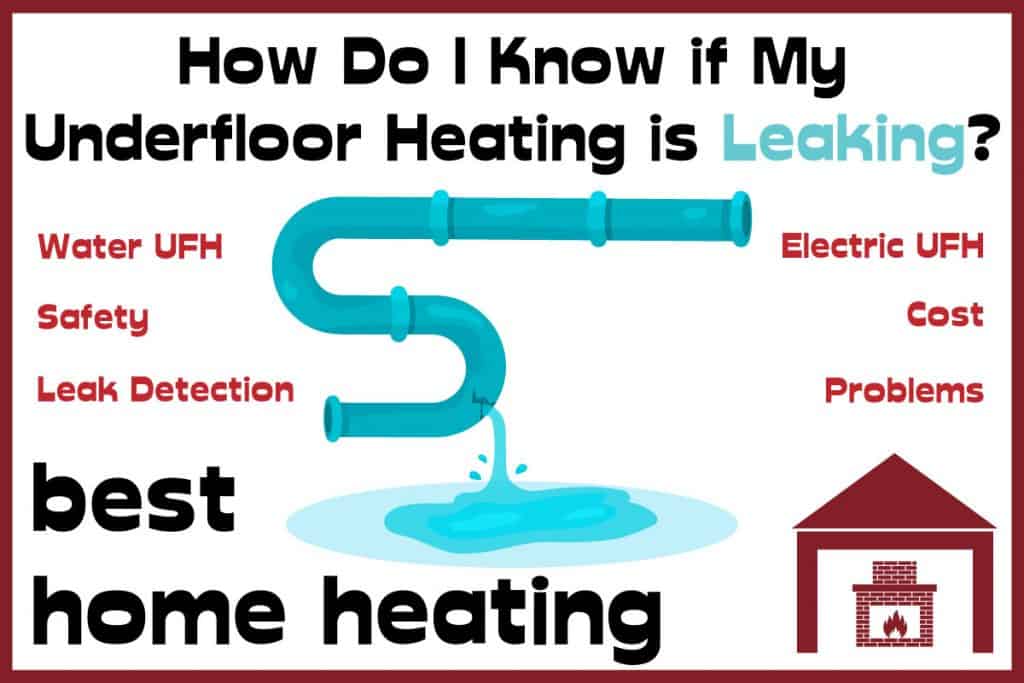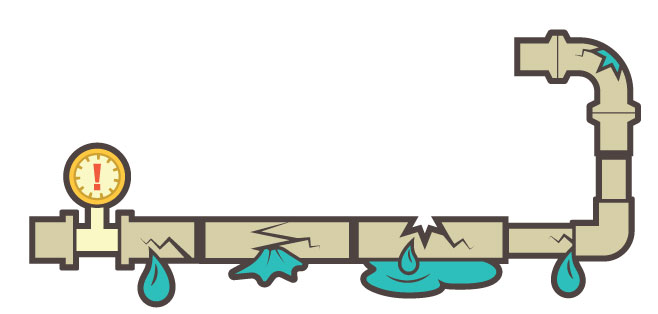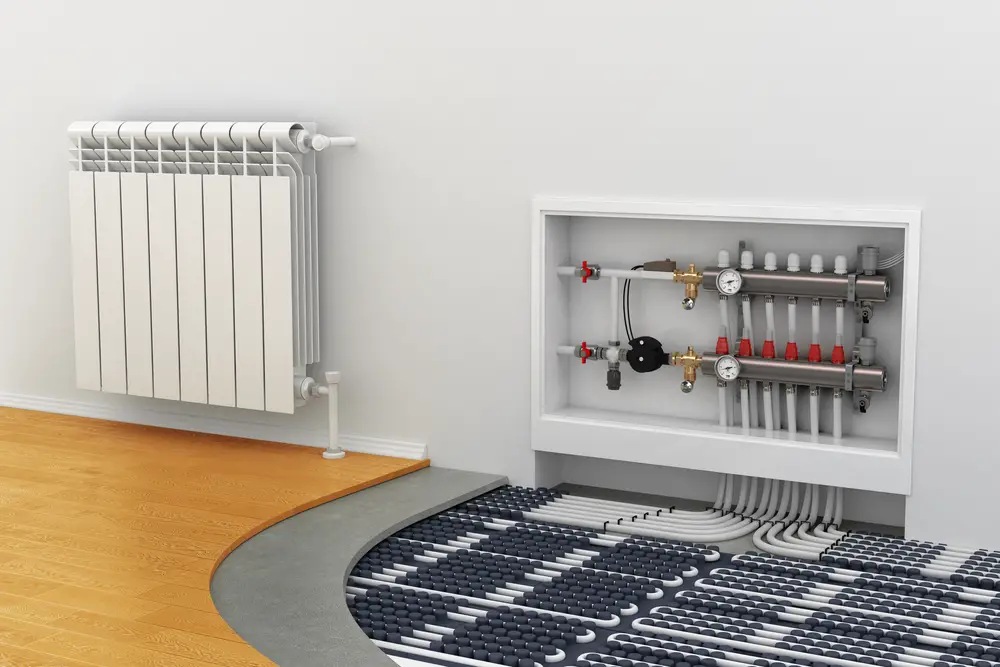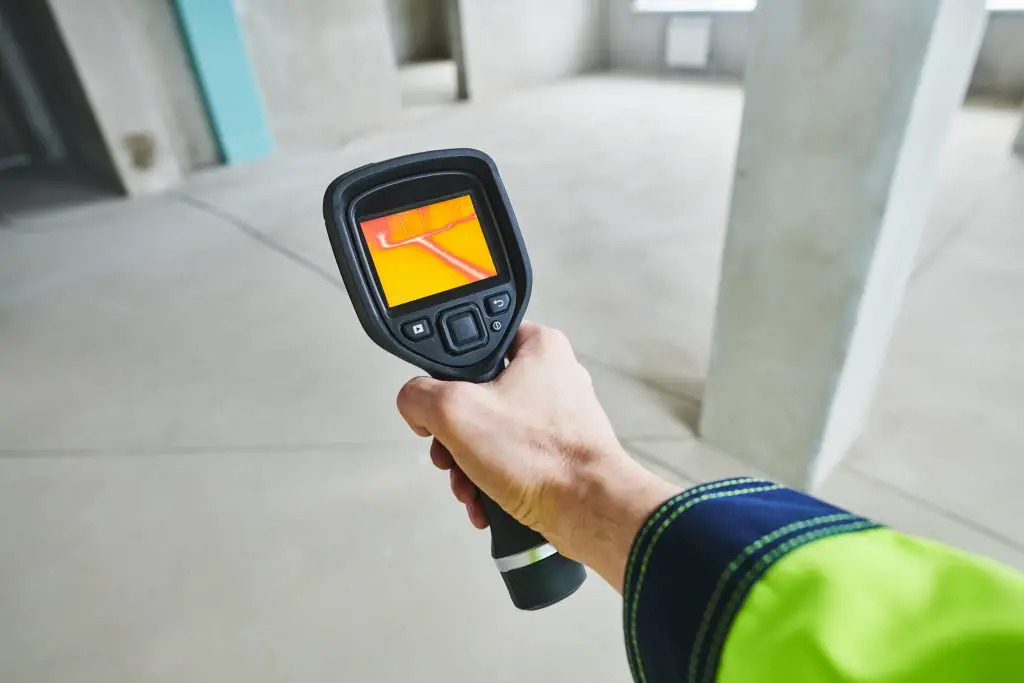Water underfloor heating systems can leak, and this can be very problematic. Underfloor heating systems should always be installed and adequately tested by a reputable professional. This post examines why leaks happen with underfloor heating and how to find and deal with them.
Leaks in underfloor heating systems may become apparent by damp patches on your floor or could be more subtle. Loss of pressure, loss of effective heating, mold, smells and other floor changes can all be signs of a leak. Hire a leak detection and repair professional to find and fix your leak.

Water Underfloor Heating Explained
Water underfloor heating systems feature a series of underfloor pipes connected to the boiler or other heat source, which circulates the warm water around the floor to heat your home.
Using a manifold, which is a central system allowing the pipes to function together, you can connect the heat source to the pipes.
The underfloor heating system distributes a lower temperature of warm water through a network of pipes beneath the finished floor. The temperature in a property or individual zones is controlled by intelligent thermostats to maintain consistency. The energy efficiency of underfloor heating is around 25% greater than that of radiators.
Heat pumps, stoves, standard boilers, combination boilers, condensing boilers, or biomass boilers can all be used for underfloor heating. Each zone of underfloor heating is served by an underfloor heating manifold.
It goes without saying that leaks are not a problem with electric underfloor heating.
How do Leaks in Underfloor Heating Happen?
The wet system should be fully pressure tested after installation, and the screed (if it is a screeded system) should not be laid until all of the pipework has been tested for leaks.
Before laying the screed and the flooring, any problems identified should be rectified. Damaged pipe coils, for example, should be completely replaced, to ensure there are no at-risk joints under the floor. It will be very disruptive to go back into the piping once the UFH has been covered and the flooring placed on top.
Leaks can also be caused if pipes run through walls without a pipe conduit. This can have serious consequences post-installation. As pipes cross through or beneath walls, the conduit acts as a protective sleeve. Besides protecting the pipework, the pipe conduit will also insulate the pipe and prevent excessive heat buildup in one area.
There may also have been a failure of the installing team to follow proper installation procedures and to follow an appropriate underfloor heating design layout. This emphasizes the importance of asking a reputable professional to install your system.
What happens if Underfloor Heating Leaks?
Undetected leaks can cause damage at the point of the leak as well as long-term damage to your heating system due to the rust inhibitor being diluted each time the pressure is topped up. Ultimately, rusted radiators and pipes will have to be replaced due to rust particles in the system.
The leaking water with start to spread out below your tiles or flooring. It might come outside on the surface. That can cause dampness and mold on the floor. You may even suffer a large volume running leak that causes significant problems.
How to tell if Underfloor heating is leaking – What are the signs?
Some signs of underfloor heating leaking include:
- Signs of dampness like the smell, change in floor color, swelling of the floor, damp patches.
- Loss of boiler pressure or failure of the boiler itself.
- Constant filling of the feed and expansion tank would result in more water bills.
- Loss of heat or uneven heating.
- Condensation and mould.
The most common indicator of a leak in the underfloor heating system is a drastic loss of pressure. By testing the pressure in each zone separately, you can determine if there is an issue with your installation and where the leak lies.

What precautions you can take to avoid leaks?
An underfloor heating system ought to go under pressure test after it has been installed, and the screeded system ought not to be laid until all the pipework has been checked for spills. Any issues recognized ought to be amended before the screeded system and then the deck is set.
- Regular pressure tests should be performed when the system is serviced
- Protect your pipes.
- Prevent them from freezing
- Insulate the edges.
- Inform other tradespeople that the underfloor piping has been installed.
What is the effect of extremely cold weather on the chances of leakage?
Be sure that the pipework is purged of water if the site is exposed or if frequent freezing temperatures are forecast. The damage caused by freezing is hard to detect visually and weakens the pipe structure, causing leaks several years later.
How do you find a leak in your Underfloor heating?
Leaking pipes are a problem, but when they are buried under the floor, the problem becomes more difficult to sort out. It can be hard to find a leak in underfloor heating, but there are a number of ways to deal with it. We recommend you ask a professional to locate the leak for you as this will ensure you’re not removing excess flooring area to find the problem area.
- Thermal imaging can usually be conducted after a thorough visual inspection of the visible parts of the system. You can view the temperature of the floor with this technology. If you see any significant variations, that may lead us to the cause.
- It is always a good idea to perform a pressure test. The valves on the manifold can be left closed during a pressure test. On each circuit, there are two isolation points. Decorator caps protect the valve and are used to control them. If the cap is attached to the manifold, or if it has been removed completely, the pressure should be tested with the cap unwound. You will pressurize the manifold rather than the water if you forget to remove the cap.
- Your heating professional can also use tracer gases, which are extremely effective. By pumping the harmless gas into the underfloor heating system, you are able to watch where it escapes, allowing you to pinpoint the leak’s exact location.
- Other options include acoustic surveys and even the use of an endoscope. A highly sensitive microphone is clamped onto the pipe and listens for the sound of water escaping. This is very helpful if you’re trying to find a leak under a floor. It is possible to determine the exact location of a leak by using the correlators along a length of pipe when certain conditions are met.

Can leaks in Underfloor Heating be Repaired?
An underfloor heating leak can be repaired relatively easily – the most difficult part is usually locating the leak, removing the flooring, and getting access to the pipe. It’s crucial to locate the leak to the greatest degree of accuracy possible. By locating the exact leak point, you can minimize the amount of floor that needs to be removed to reach the pipe.
There are two main methods for sealing a leak in a pipe – epoxy putty and self-amalgamating waterproof pipe repair tape. Which one to use will depend on how complicated the repair is.
Self-amalgamating waterproof pipe repair tape
One option a professional may use to repair a leaking underfloor heating pipe is self-amalgamating waterproof pipe repair tape.
If there is sufficient space around the pipe, a pipe repair tape made of self-fusing silicone, such as Wrap & Seal Pipe Burst Tape, provides a high-pressure repair that can resist temperatures up to 250°C [2].
Applied in under 30 minutes, self-fusing silicone tape is easy to use. By wrapping the tape around the pipes, you anchor the tape near the leak area and stretch it by as much as possible. Over time, the tape will fuse into a solid rubber band, completely sealing the leak.
Epoxy putty
Holes in underfloor heating pipes may also be able be repaired by epoxy putty.
It is recommended that epoxy putty be used instead of Wrap & Seal if there is insufficient space for the product to be stretched effectively. It consists of two soft parts, and when these parts are mixed together, a chemical reaction creates a material that is extremely hard.
It is easiest to repair underfloor heating pipes with epoxy putty sticks. They come pre-formatted with two parts. Putty is easily applied by cutting off the required amount and kneading it by hand to initiate the reaction.
Putty can be squeezed into the holes in the pipe while it is still soft, filling the damaged area. In most cases, a functional cure will have been achieved within an hour, depending on the formulation of the putty used.
Underfloor heating leak detection – Should I ask a Professional?
If you are asking yourself this question, you will need help finding water leaks under a floor. The last thing a homeowner will want to do is start lifting floor coverings and floorboards randomly. Not least because so many homes today are covered in expensive floor coverings, and any misdiagnosis can lead to costly mistakes. However, you can follow these simple non-destructive tricks to detect the leaks
- Large leaks in pressurized pipes make a noise, you may be able to hear this.
- It is common for hot spots to appear on the surface of floor coverings when water leaks on hot pipes. Feel for these spots.
- Domestic building materials react or respond to water by distorting or deteriorating under the pressure created by water vapor.
If you cannot locate your leak using these simple methods, then it’s time to call in a leak detection expert. They may also be the person you need to do the repair, or they may recommend another tradesperson to do this work.

Conclusion – How likely is a leak in Underfloor Heating?
A leak is extremely unlikely, as the pipes have a lifespan of over 50 years [ ]and there are no joints in the pipe system. If a leak does develop, you should hire a plumbing professional with expertise in leak detection to identify the source.
Leak repair may be disruptive depending on your floor surface, the type of screed used, and the damage the leak has caused to surrounding floor structures. Disruption can be minimized by locating the source of the leak early. It is worth working out if your home insurance will cover costs for damage caused by underfloor heating leaks.
Most system damage occurs during installation when the underfloor heating pipe is accidentally cut or otherwise damaged.
Check out my post on the safety of underfloor heating systems here.
Lots more Underfloor Heating Information Here
- What Depth is Required for Underfloor Heating?
- Turning on Underfloor Heating for the First Time – How Long to Wait?
- Can you lay Vinyl flooring over underfloor heating?
- Do Tiles Crack With Underfloor Heating?
- Can You Heat a Whole House With Underfloor Heating?
- Can You Have Underfloor Heating Upstairs?
- Will Underfloor Heating Raise My Floor? – Underfloor Heating Layers Explained
- Can I put furniture on top of underfloor heating?
- How Do I Know If My Underfloor Heating is Leaking?
- Can You Combine Underfloor Heating With a Ground Source Heat Pump?
- Is Underfloor Heating Safe?
- Does Underfloor Heating Add Value to a Property?
- Can you have Wooden Floors with Underfloor Heating?
- Can Underfloor Heating Cause a Fire?
- What temperature should Underfloor Heating be set at?
- Can I Put a Rug Over Underfloor Heating?
- How Long Does it Take for Underfloor Heating to Warm Up?
- Why is my Underfloor Heating Noisy?
- Why is my Underfloor Heating Patchy?
- How do I know if My Underfloor Heating is Working? – Common Problems & Fixes
- What can go wrong with underfloor heating?
- Can you Combine Underfloor Heating with an Air Source Heat Pump?
- Do you keep underfloor heating on all the time?
- Does Underfloor Heating work with Smart Thermostats?
- Kitchen Underfloor Heating – Should Underfloor Heating go Under Kitchen Units?
- How much energy does Underfloor Heating use?
- Underfloor Heating in Summer and Winter
- Lifespan of Underfloor Heating
